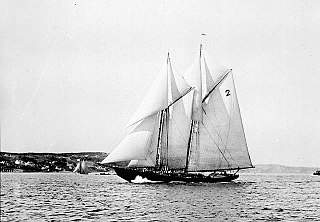
Bluenose was a fishing and racing gaff rig schooner built in 1921 in Nova Scotia, Canada. A celebrated racing ship and fishing vessel, Bluenose under the command of Angus Walters, became a provincial icon for Nova Scotia and an important Canadian symbol in the 1930s, serving as a working vessel until she was wrecked in 1946. Nicknamed the "Queen of the North Atlantic", she was later commemorated by a replica, Bluenose II, built in 1963. The name Bluenose originated as a nickname for Nova Scotians from as early as the late 18th century.
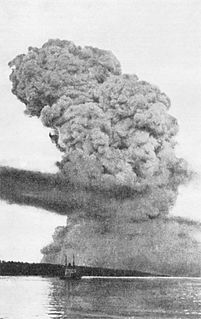
The Halifax Explosion was a disaster that occurred in Halifax, Nova Scotia, Canada, on the morning of 6 December 1917. SS Mont-Blanc, a French cargo ship laden with high explosives, collided with the Norwegian vessel SS Imo in the Narrows, a strait connecting the upper Halifax Harbour to Bedford Basin. A fire on board the Mont-Blanc led to a massive explosion that devastated the Richmond district of Halifax. Approximately 2,000 people were killed, largely in Halifax and Dartmouth, by the blast, debris, fires, or collapsed buildings, and an estimated 9,000 others were injured. The blast was the largest human-made explosion at the time, releasing the equivalent energy of roughly 2.9 kilotons of TNT (12 TJ).

Tatamagouche is a village in Colchester County, Nova Scotia, Canada.

SS Atlantic was a transatlantic ocean liner of the White Star Line that operated between Liverpool, United Kingdom, and New York City, United States. During the ship's 19th voyage, on 1 April 1873, she struck rocks and sank off the coast of Nova Scotia, Canada, killing at least 535 people. It remained the deadliest civilian maritime disaster in the North Atlantic Ocean until the sinking of SS La Bourgogne on 2 July 1898 and the greatest disaster for the White Star Line prior to the loss of Titanic in April 1912.

John Taylor Wood was an officer in the United States Navy and the Confederate Navy. He resigned from the U.S. Navy at the beginning of the American Civil War, and became a "leading Confederate naval hero" as a captain in the Confederate Navy. He was a lieutenant serving aboard CSS Virginia when it engaged USS Monitor in 1862, one of the most famous naval battles in Civil War and U.S. Naval history. He was caught in 1865 in Georgia with Confederate President Jefferson Davis' party, but escaped and made his way to Cuba. From there, he got to Halifax, Nova Scotia, where he settled and became a merchant. His wife and children joined him there, and more children were born in Canada, which is where he lived out the remainder of his life.
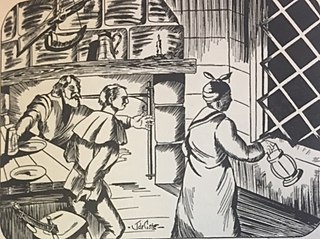
The Battle of Fort Cumberland was an attempt by a small number of militia commanded by Jonathan Eddy to bring the American Revolutionary War to Nova Scotia in late 1776. With minimal logistical support from Massachusetts and four to five hundred volunteer militia and Natives, Eddy attempted to besiege and storm Fort Cumberland in central Nova Scotia in November 1776.

SS Bear was a dual steam-powered and sailing ship built with six-inch (15.2 cm)-thick sides which had a long life in various cold-water and ice-filled environs. She was a forerunner of modern icebreakers and had a diverse service life. According to the United States Coast Guard official website, Bear is described as "probably the most famous ship in the history of the Coast Guard."
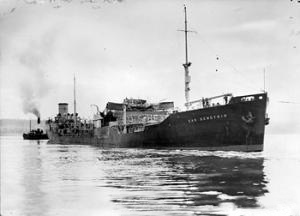
MV San Demetrio was a British motor tanker, notable for her service during the Second World War. She was built in 1938 for the Eagle Oil and Shipping Company. In 1940 she was damaged by enemy action in mid-Atlantic, abandoned by her crew but later re-boarded and successfully brought into harbour. She was the subject of a 1943 feature film, San Demetrio London, one of the few films that recognised the heroism of the UK Merchant Navy crews during the War.

Theodore Tugboat is a Canadian children's television series about a tugboat named Theodore who lives in the Big Harbour with all of his friends. The show originated in Halifax, Nova Scotia, Canada as a co-production between the CBC, and the now defunct Cochran Entertainment, and was filmed on a model set using radio controlled tugboats, ships, and machinery. Production of the show ended in 2001, and its distribution rights were later sold to Classic Media. The show premiered in Canada on CBC Television, then went to PBS, was on Qubo in the United States, and has appeared in eighty different countries.

The 84th Regiment of Foot was a British regiment in the American Revolutionary War that was raised to defend present day Ontario, Quebec and Atlantic Canada from the constant land and sea attacks by American Revolutionaries. The 84th Regiment was also involved in offensive action in the Thirteen Colonies; including North Carolina, South Carolina, Georgia, Virginia and what is now Maine, as well as raids upon Lake Champlain and the Mohawk Valley. The regiment consisted of 2,000 men in twenty companies. The 84th Regiment was raised from Scottish soldiers who had served in the Seven Years' War and stayed in North America. As a result, the 84th Regiment had one of the oldest and most experienced officer corps of any regiment in North America. The Scottish Highland regiments were a key element of the British Army in the American Revolution. The 84th Regiment was clothed, armed and accoutred the same as the Black Watch, with Lieutenant Colonel Allan Maclean commanding the first battalion and Major General John Small of Strathardle commanding the second. The two Battalions operated independently of each other and saw little action together.

SS Foundation Franklin was a seagoing salvage tug built for the Royal Navy as HMS Frisky in 1918. In 1924, the tugboat was sold and renamed Gustavo Ipland before being acquired in 1930 by Foundation Maritime and renamed Foundation Franklin. The tugboat became famous for many daring salvage operations and rescues between 1930–1949. Her many rescues and salvage triumphs were celebrated in Farley Mowat's book The Grey Seas Under. In 1948, the ship was damaged in a hurricane and not considered repairable. The tug was broken up for scrap in 1949 at Halifax, Nova Scotia.
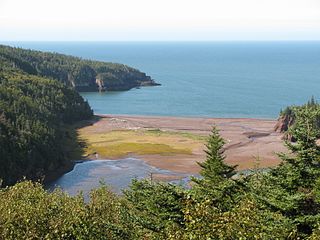
Eatonville is a former lumber and shipbuilding village in Cumberland County, Nova Scotia. It includes a large tidal harbour at the mouth of the Eatonville Brook beside several dramatic sea stacks known as the "Three Sisters". It was founded in 1826 and abandoned in the 1940s. The site of the village is now part of Cape Chignecto Provincial Park.

SS Letitia was an ocean liner built in Scotland for service with the Anchor-Donaldson Line. She continued to serve with its successor company Donaldson Atlantic Line. At the start of the Second World War in September 1939, the British Admiralty requisitioned the ship for service and had it converted to serve as an armed merchant cruiser. She was withdrawn from this service in 1941 to become a troop ship.

Acushnet – a steel-hulled revenue cutter – was launched on 16 May 1908 at Newport News, Virginia, by the Newport News Shipbuilding and Drydock Co.; sponsored by Miss Alayce Duff; and commissioned at Baltimore on 6 November 1908. She saw service as a United States Revenue Cutter Service cutter, a U.S. Navy fleet tug, and as a U.S. Coast Guard cutter. She was taken out of service 8 January 1946.

SS Imo was a steamship that served in passenger and freight trades and later as a whaling supply ship. Christened SS Runic, she was bought, sold and renamed numerous times during her career. In 1917, Imo was under Norwegian registry chartered by the Belgian Relief Commission to bring supplies to war-ravaged Europe.
Stella Maris was a steamship built in 1882 as the Royal Navy gunboat HMS Starling and converted to steam tug in 1905. Stella Maris played a major role in the events of the Halifax Explosion in 1917.

Nova Scotia is a Canadian province located in Canada's Maritimes. The region was initially occupied by Mi'kmaq. The colonial history of Nova Scotia includes the present-day Canadian Maritime provinces and the northern part of Maine, all of which were at one time part of Nova Scotia. In 1763 Cape Breton Island and St. John's Island became part of Nova Scotia. In 1769, St. John's Island became a separate colony. Nova Scotia included present-day New Brunswick until that province was established in 1784. During the first 150 years of European settlement, the colony was primarily made up of Catholic Acadians, Maliseet and Mi'kmaq. During the latter seventy-five years of this time period, there were six colonial wars that took place in Nova Scotia. After agreeing to several peace treaties, this long period of warfare ended with the Halifax Treaties (1761) and two years later when the British defeated the French in North America (1763). During these wars, Acadians, Mi'kmaq and Maliseet from the region fought to protect the border of Acadia from New England. They fought the war on two fronts: the southern border of Acadia, which New France defined as the Kennebec River in southern Maine. The other front was in Nova Scotia and involved preventing New Englanders from taking the capital of Acadia, Port Royal, establishing themselves at Canso.
Saladin was a British barque that made voyages between Britain and the coast of Peru, carrying shipments of guano. The ship is best known for its demise in an act of mutiny, murder and piracy which began with the murder of its captain and officers and ended with the ship being stranded off the coast of Nova Scotia on 21 May 1844, followed by the last major piracy trial in Canada.

Point Chebucto is a harbour tug that was built at the Halifax Shipyard in Halifax, Nova Scotia, Canada in 1992. She is one of very few harbour tugs that were built at the Halifax Shipyards. She has been aiding ships in and out of Halifax Harbour and later Port Hawkesbury, Nova Scotia since she was registered in January 1993. The tug was built for Eastern Canada Towing Limited, a company that has been around for over 60 years. The tug is named after the point at Chebucto Head, continuing the tradition of Eastern Canada Towing of naming its tugs after points. Eastern Canada Towing took over Foundation Maritime's work in the field of Harbour, Coastal and Deep-Sea tow and salvage. The firm owns and operate a fleet of modern tugs ranging from 1250 HP - 5400 HP. Most tugs are ice strengthened, with several having Ice Class 1 certification. Their head office is also in Halifax. Eastern Canada Towing was purchased in 2007 by Svitzer, a tug boat division of Maersk.
SS Havana was a one deck steamship schooner equipped with three masts. She was built in 1891 at Hantsport, Nova Scotia by George W. Churchill. Owned by Farquhar, J.A. & Co. and captained by James A. Farquhar, Havana sank at anchor on 26 April 1906 after colliding with SS Strathcona.
















